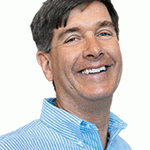Clark Talks Turf: Photosynthesis and respiration

Clark Throssell
Jack Fry, Ph.D., is a turfgrass scientist at Kansas State University. Jack conducts research on water use, physiology and zoysiagrass cultivar development and teaches students and turf professionals. You may reach Jack at jfry@ksu.edu for more information.
Q: Briefly define photosynthesis and respiration.
Photosynthesis is the process of a green plant with chloroplasts, in the presence of light and water, taking in carbon dioxide and transforming the carbon into a sugar, which is stored energy. The enzyme rubisco catalyzes the initial fixation of carbon to a larger molecule. Respiration is the reverse of photosynthesis — taking sugars and consuming them for energy (sugars plus oxygen) while producing carbon dioxide and water. Respiration takes place in all living cells, green or not, such as leaves, stems and roots.
Q: In cool-season grasses, what is the relationship between air temperature and the rate of photosynthesis and respiration?
Photosynthesis increases from the upper 30s to 70 degrees F, starts to decline when air temperatures are in the low 70s and declines rapidly as air temperature reaches 90 degrees F. The rate of photosynthesis drops by half as the air temperature increases from 70 degrees to 90 degrees F. Respiration increases with increasing temperatures until about the mid-90s F, then it declines as well.
At air temperatures of 75 degrees F and above, photosynthesis declines while respiration increases, resulting in an energy imbalance, and eventually an energy deficit. In other words, energy consumption exceeds production when air temperatures increase above the mid-70s.
Q: What are the long-term consequences to cool-season turf plants when respiration exceeds photosynthesis?
The long-term consequence is the potential for starvation, particularly at mowing heights used on putting greens, especially in summers like 2018. The plant can continue to grow (sustain itself) if reserve carbohydrates are present. Once reserves are gone, the plant will begin to lose tissues that it can no longer support, usually beginning with roots, and working to shoots.
Q: In warm-season grasses, what is the relationship between air temperature and the rate of photosynthesis and respiration?
Warm-season grasses are more photosynthetically efficient at higher temperatures and the rate of photosynthesis increases from 50 degrees to 95 degrees F, with the ideal temperature for photosynthesis at 80 degrees to 95 degrees F. The rate of respiration increases as temperature increases to about 95 degrees F. Above 95 degrees F, the rate of respiration in warm-season grasses starts to decline.
One of the challenges of managing warm-season grass putting greens comes in spring and fall, when the grass is green, but the rate of photosynthesis is low because of cool temperatures. Warm-season grass under these conditions produces little energy, resulting in stress and disease outbreaks.
Q: Are there practical steps a superintendent can take to increase photosynthesis and decrease respiration in cool-season grasses during periods of high temperature?
Go back to the photosynthetic reaction; more green leaf tissue equals more “engine” to manufacture sugars because of more cells and more chloroplasts. Raise
the mowing height and/or alternate days of mowing and rolling. Provide
adequate water for plant health so the plant can cool itself. Make sure the green receives full sunlight all day by removing and/or trimming trees. Good air flow across the green also helps the plants cool themselves.
Q: Is there anything else you would like to add?
A well-conceived set of maintenance standards during difficult weather can be a big help to everyone at the golf course. Maintenance standards set the long-term direction for the course and include expectations and maintenance strategies during times of extremely stressful hot weather. Standards that include more realistic expectations for putting greens during extended periods of hot weather and a focus on keeping the turf alive keeps everyone working toward the same long-term goal. Communicating what the problems are and what steps you’ve taken to address them also is critical to surviving a long, hot summer.










